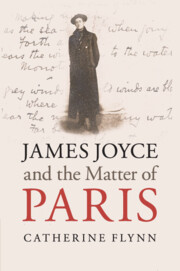Book contents
- James Joyce and the Matter of Paris
- James Joyce and the Matter of Paris
- Copyright page
- Contents
- Figures
- Acknowledgments
- Introduction: The Matter of Paris
- Chapter 1 Paris Encountered
- Chapter 2 Paris Recognized: Stephen Hero and Portrait
- Chapter 3 Paris Digested: “Lestrygonians”
- Chapter 4 Paris Reenvisioned: “Circe”
- Chapter 5 Paris Profanely Illuminated: Joyce’s Walter Benjamin
- Chapter 6 Paris Compounded: Finnegans Wake
- Afterword
- Index
Afterword
Published online by Cambridge University Press: 05 September 2019
- James Joyce and the Matter of Paris
- James Joyce and the Matter of Paris
- Copyright page
- Contents
- Figures
- Acknowledgments
- Introduction: The Matter of Paris
- Chapter 1 Paris Encountered
- Chapter 2 Paris Recognized: Stephen Hero and Portrait
- Chapter 3 Paris Digested: “Lestrygonians”
- Chapter 4 Paris Reenvisioned: “Circe”
- Chapter 5 Paris Profanely Illuminated: Joyce’s Walter Benjamin
- Chapter 6 Paris Compounded: Finnegans Wake
- Afterword
- Index
Summary
With James Joyce and the Matter of Paris, I have presented Joyce as a person embedded in an early, burgeoning moment of consumer capitalism. Here he writes as an aspiring member of a community of literary artists who set their efforts within and against that moment in cultural history. In this effort, and over the long course of his career, I have followed him successively reframing his style, reconfiguring the strategies of his Parisian literary milieu so as to resist and reorient those external, deforming pressures of commercialism. What comes of this shared endeavor is a somatic art, one that assimilates and metabolizes, unmakes and remakes those forces of transaction and calculation into a new medium of human interaction. From his 1903 representation of women on a city street to the ville énorme of Finnegans Wake, he finds ways to figure the recovery and sustenance of spontaneity, imagination, and joy in personal interactions.
- Type
- Chapter
- Information
- James Joyce and the Matter of Paris , pp. 236Publisher: Cambridge University PressPrint publication year: 2019

